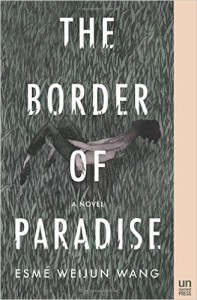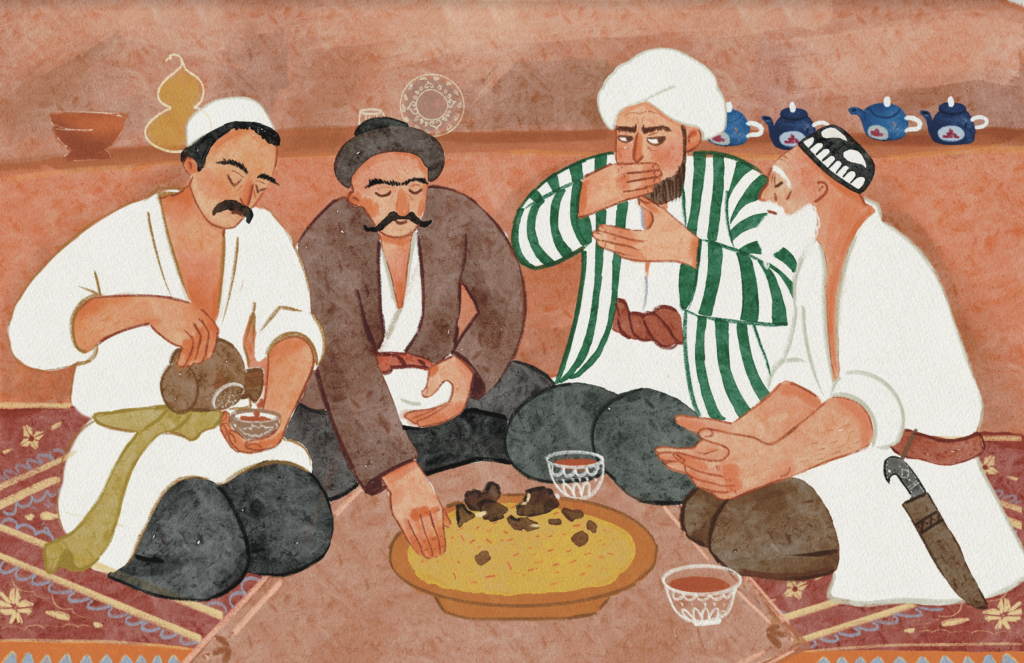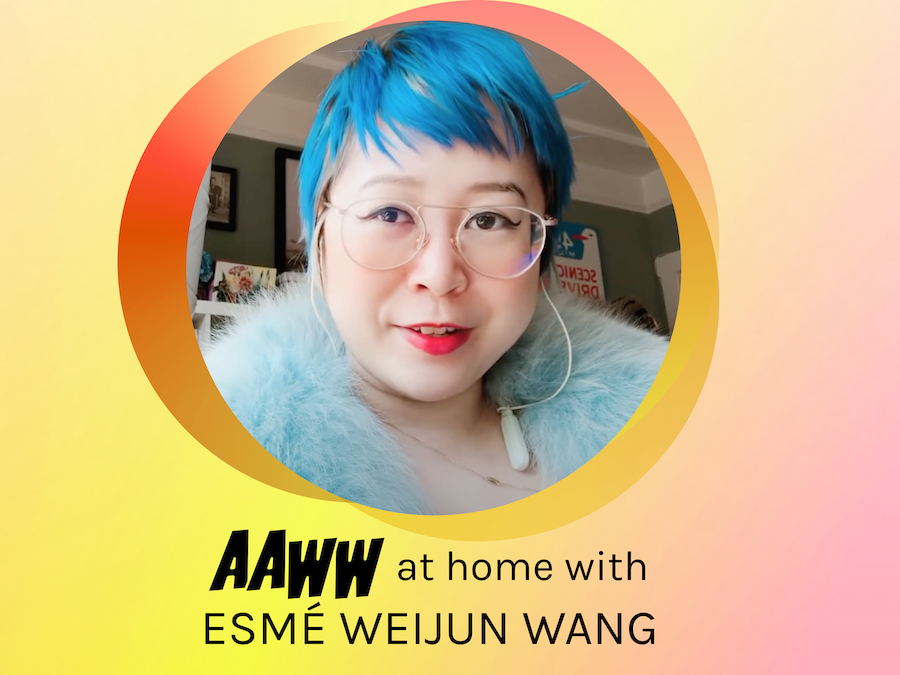Writer and mental health advocate Esmé Weijun Wang talks about languages, love, immigrant children, and her debut novel, The Border of Paradise

May 9, 2016
An excerpt from The Border of Paradise
My heart sighed. I curled up beside him in my fancy dress, avoiding the wetness of whiskey, and pressed my face into his ribs. He rubbed my head in slow circles, and I thought, I am happy, I am happy, I am happy. I inhaled the aftershave he had splashed on that morning that smelled of something dark and sour, like small animals and the color brown and himself. When we lay together there was no need to speak, and I preferred it that way because when we didn’t speak we could be any husband and wife, with no struggle in it. We lay in that bed and kissed tenderly, and then we took our set of matching luggage and left. I imagined Mrs. Nowak lying in bed with a towel over her forehead. She didn’t try to say good-bye.
David and I took a taxi back to the hotel because I didn’t like the subway, and he was hemorrhaging money in those days. David booked a new room, and then he was hungry; he liked diners to the exclusion of all else, and for the longest time I thought that all American restaurants were diners, and that all American menus contained hamburgers and french fries and malts.
* * *

Esmé Weijun Wang’s debut novel, The Border of Paradise, is an intricately woven, gothic family saga that examines the legacies of decisions and indecisions made long ago. David Nowak, heir to the Nowak Piano Company, abandons his old life in Brooklyn following the end of his relationship with his first love, Marianne. He move to Taiwan, where he meets Daisy, the intelligent, crafty daughter of a local madame, and makes her his bride. But David’s deteriorating mental health and the isolated life they choose to make after moving back to America lead to a gradually narrowing world for their children, William and Gillian, who are forced to carve out their own path in a world they only barely recognize.
Esmé Weijun Wang is a nonfiction writer and prominent mental health advocate and speaker. She and I spoke on the phone about languages, love, immigrant children, and the holy ghost.
—Larissa Pham
Larissa Pham: Let’s start with one of the more prominent features of the book—language. There are a few different spoken and written languages, and then there are also blank spaces where there’s no language at all—could you speak to the use of those?
Esmé Weijun Wang: I chose to use English as well as Chinese in two ways: Chinese characters and pinyin, which is the romanization. There is some Taiwanese, but it’s mostly Chinese characters and pinyin. Part of my thought process in using the two has to do with levels of opacity. With the Chinese characters—the pictograms—there’s basically nothing you can do there if you don’t know Chinese. It’s unlike something like Junot Díaz’s work, where he uses Dominican Spanish without translation and you can at least type it into Google Translate and get a very basic understanding. With Chinese characters, there’s nothing you can do to get that translation, and so there are parts of my book where, unless you’re “in,” you’re not going to understand what the character is saying. And I did that deliberately.
You mentioned the blank spaces—the blank spaces are the correlation to that. Daisy Nowak, the Taiwanese main character, often uses the blank spaces to depict parts of conversation in English that she doesn’t understand. And I wanted there to be times when Daisy got to be the insider, where her use of language takes a primary stance. That’s when I used the Chinese characters. I actually came up with a number of rules for using the Chinese characters, versus pinyin, versus English. One of those rules was that I would use Chinese characters if she was speaking to another character who also spoke Chinese, and only if that particular portion of speech were about something the two of them shared in a very close-knit cultural space.
One of the most striking examples I noticed was when Daisy’s thinking to herself and she’s like, “I could have said this, or I could have said this, but I didn’t do anything.” And there’s this sentence that’s completely obscure to me.
Yes, and that line is probably the most important, or obvious, use of Chinese characters in the entire book, because it’s so alienating to anybody who doesn’t speak Chinese but it’s also incredibly comforting to Daisy herself. That line occurs in a scene where Daisy is feeling very alienated from her new, Polish-American husband. And so she thinks to herself, I could’ve told him this, this line of Chinese. And to her, it makes total sense. But it wouldn’t make sense to him.
I tweeted this:
https://twitter.com/lrsphm/status/718490010031374336
I thought you’d written one of the most authentic interracial relationships I’d ever read—
Haha! Yes!
—And in terms of this book, the opacity of each character’s thoughts, that they don’t really understand each other, creates these chasms that run so deep. That seemed to me to really represent the reality of loving someone who you don’t understand. And who doesn’t necessarily understand you.
Yes, and David himself admits in the opening of one of his chapters that what drew him to Daisy was how exotic she was. There’s an erotic image of her that he’s projected on her, before they get married. The phrase “The Other” is never used in the book, but it’s there—how he finds the other attractive, because it’s so different from himself.
There’s this tendency, or maybe desire, in contemporary art-making to say, “This is okay! It works! It’s fine! Race doesn’t matter, these things don’t matter.” But they really do.
I think we—and I say we as a culture, as a Western art-making and literary culture, tend to fall back on this idea that if it’s not outright fetishism, then it’s completely without difficulty. Which I think is not necessarily the case.
I do have this story, which I can trot out sometimes, about how when I was in high school I dated this white teenage boy and one day I discovered a whole stash of Asian fetish porn magazines in his couch.
Oh nooooo!
Which was such an uh-oh moment in my life! And also this moment of “Oh, this is what’s going on.” I had no idea. I thought we were just having a nice relationship.
You framed David and Daisy’s relationship, too, with this undercurrent of the body. There are the various spoken languages you use, and there’s also this language of the body. There are scenes where they’re next to each other, and they’re not talking, and that’s something that they understand.
I find it really interesting to think about how much of a relationship—any relationship, interracial or not—is dependent on wordlessness. Things that can be conveyed without speaking. This language that we tend to fall back on, talking all the time, wanting to discuss things, process things.
I’m going to be such a cliché here, but reading Daisy made me think of my own mother. And how it’s hard to ascribe an interior life to one’s parents, sometimes. But there is a way that my mother came to be herself.
Yes!
And I don’t necessarily agree with the way she raised me, but she’s still a person.
I think this is something pretty much all people go through—realizing the humanity of their parents. But I think with the children of immigrants, there’s something very particular about figuring out how difficult that experience must have been.
For example, my mother had me when she was in her early twenties—which I cannot imagine at all now! Recently, she started sending me scans of her journal from when I was a newborn, and I was reading them and just crying. One of the scans describes how she turned around and tried to wave to her parents as she was leaving, as she was getting on the flight to leave Taiwan, and there was something so sad about that. There are other parts of the journal, too, where she’s practicing her English… I would say she had a traumatic experience as an immigrant coming to the United States, and having a newborn almost immediately after arriving in this new country. There’s definitely a lot that I carried into my fiction from living with my mom and trying to imagine her experience.
I’m thinking now of the scenes in San Francisco. There are so many tight worlds in that book! They’re very consciously inscribed universes, that feel safe or are supposed to feel safe.
Yes! There’s a lot in the book about the safety of isolation. Or the alleged safety of isolation.
Which sort of brings us to the big elephant in the novel, which is mental illness. It’s so acutely described from so many different perspectives, and isn’t ever really labeled as such. Your background as a nonfiction writer and as an advocate really informed my reading of the first section, too.
I knew there was going to be a character who commits suicide, or ends his own life in the book. What I decided pretty early on was that with David, the person who suffers the most acutely and most obviously from mental illness in this book—what I wanted to convey was the kind of mental illness that did not have an obvious diagnosis. It’s not labeled, and I did that very consciously. Something I’ve noticed in other novels is that when they put a label on a character, it tends to feel like that character becomes a receptacle for a DSM diagnosis. All of a sudden the character gets five pages about how they’re not sleeping at night because they have bipolar disorder and they’re manic, et cetera. Part of the decision was also informed by my own experience living with mental illness, which is diagnosed as schizoaffective disorder bipolar type, but another part of it was informed by my years working in a psychology lab at Stanford. I spent hundreds of hours doing clinical interviews with people, with their various diagnoses, and what I noticed is that in science, in research, you’re trying to get these really clear-cut subjects for your studies. But what would often happen was that, over the course of these two to three hour long interviews, this person would “fit” for our study in all of these ways, but there’d be a little quirk, or couple of quirks. And then they would no longer qualify.
It was in doing that research, and in living my own life, that I realized how difficult it is to fit people in boxes when it comes to mental illness. Either you end up with seven different diagnoses, or you end up with this murky, “well, something’s wrong and it looks the most like this, but we’re not really sure.”
I’m thinking now of David’s own reports from the field, as it were, and his children’s descriptions of him. There’s a real sense of interiority there, that this has been written from someone who knows very intimately what it’s like to both live and observe it. It’s a portrayal of mental illness that I haven’t seen before.
I tried really hard to write about certain kinds of experiences in a way I hadn’t seen before. Like I was really interested in writing about what it’s like to have a hallucination. I definitely wanted it to be more than just, “I saw this thing! But it wasn’t there.” So there is a scene in the book where David experiences a hallucination and I tried to draw that out as much as possible.
There are other moments, too, where he does things like go out into the snow without shoes on, and those feel very acutely observed.
For a lot of the book, he’s just described as being neurotic, or having neuroses—which was my way of not labeling it!
I wanted to ask you about religion.
While I was writing the book, I was thinking a lot about Catholicism. My husband is Catholic and when we were preparing to get married, I had to make the decision of whether or not to convert, because we were trying to decide whether or not to have a Catholic ceremony. So I spent about a year just reading tons of stuff, going to Mass every Sunday, reading Thomas Merton and C.S. Lewis, books about what being a Jesuit means. And I really tried to approach it from both an intellectual and spiritual point of view. In the end, I did not convert, but I think I carried a lot of that information and a lot of that desire for religion into the book. David is raised Catholic and he tries to carry Catholicism into his new life with Daisy, but that doesn’t really work out.
Something that occurred to me when I was reading TBoP was that all the characters seemed to have a different understanding of love. And I have this question now—do any of the characters know what love is?
This question really brings the discussion back to what I think the book is about, outside of a plot summary… To me, the book is about people who really want to do the right thing, and think they’re doing the right thing, the best thing, and end up completely fucking it up in the process. Because that’s what every character does.
But I also think that’s just what being a human is. I’d like to think we’re doing our best with what we have, though often it turns out badly, or not the way we thought it would.



